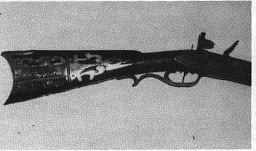
Click Here to Return To Milestones Vol 12 No 1
Before the Revolutionary War, Americans were pretty much contained to the Eastern seaboard from Maine to the Carolinas. After the war Americans and European immigrants thirsted for more land and wasted no time in pushing inward and westward. The great migration movement lasted for the next 100 years and ended around 1880. Moving westward to the lands of Virginia, Kentucky, Tennessee, Ohio and other areas; these pioneers needed covered wagons, axes, tools and guns which they acquired in southeastern Pennsylvania before moving thru the Valley of Virginia and west of the Appalachian Mountains.
The guns available and used prior to this time were just not satisfactory in this new wilderness which required an all new type of hunting rifle. These earlier guns were flintlock, large caliber, smoothbore and inaccurate muzzle loading guns that required a large lead ball and a large amount of gunpowder- both items scarce and expensive to the frontiersman. A new rifle evolved; known as the Kentucky rifle, Pennsylvania or longrifle, which was America's own rifle, born on the frontier and made by gunsmiths of German heritage, who located along the emigrant's path in the small towns of southeastern Pennsylvania. The newly evolved flintlock rifle was stocked with curly or tiger striped maple to the end of the barrel. The barrel was rifled or grooved inside to give the round lead ball spin and deadly accuracy up to 600 feet. The bore size was made smaller, saving in lead and powder; and the barrel longer for increased accuracy. On the right side of stock was a brass engraved patchbox with a hinged lid used to hold the greased one inch cloth loading patches for a tight fitting lead ball. On the left side, or cheek side of the rifle, the curly maple wood was sometimes incised carved; and often relief carved with rococo carving as fine as the earlier quality mahogany and walnut furniture found in the furniture making areas of Newport, Philadelphia and Boston. Another pleasing feature that was often added was in the form of small German silver inlays imbedded along both sides of the stock as shown in the picture in this article.
Most authorities now accept the name Pennsylvania
rifle, not the Kentucky rifle, as being correct
because the American flintlock rifle had its origin in Pennsylvania.
The name Kentucky rifle evolved after the War of 1812, the popular
imagination was caught by the performance of Andrew Jackson's
frontier riflemen at the Battle of New Orleans. These men had
come from Tennessee and Kentucky. A composer of a popular broadside
ballad about the great victory referred to them as the "Hunters
of Kentucky" and sang of their "Kentucky Rifles".
The name soon became universal after 1820 and erroneously lasts
to this day.
Thomas Allison (1786-1836) started as a rifle maker in Pittsburgh where he placed an advertisement in the Pittsburgh Gazette on March 30,1810. In 1818 we find him located in New Sewickley Township, Beaver County, where he was taxed as a gunsmith with a property valuation of $100.00 on his occupation. He lived and worked in New Sewickley Township as a gunsmith till his death in 1836. It is highly probable that he lived in the south western corner of the township near Freedom and close to the Ohio River - a highly traveled area.
The flintlock rifle pictured in this article was made by Thomas Allison circa 1825 and is engraved with his signature on the top facet of the barrel. This rifle is an excellent example of the western Pennsylvania style of gunmaking in and around the Pittsburgh area during this period. The brass pathbox is rococo engraved. The left side or cheek side has a very high relief or raised rococo carving that matches the engraved brass on the patchbox. The curly maple stock has ten engraved silver inlays imbedded in the stock. The overall length of the rifle is exactly five feet.
The late Joe Kindig, highly regarded 18th century furniture dealer in York Pennsylvania and author of the book "Thoughts on the Kentucky rifle in its Golden Age", stated in his book that..."these rifle makers were the finest artisans of the 18th century because they had to be proficient in working with wood, brass and iron". His book was the first time it was acknowledged that the Pennsylvania/Kentucky rifle was not only a weapon but a work of art.
